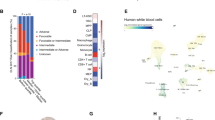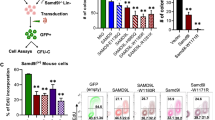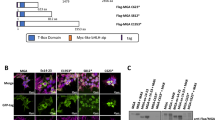Abstract
Acute myeloid leukemia (AML) is a molecularly diverse malignancy with a poor prognosis whose largest subgroup is characterized by somatic mutations in NPM1, which encodes nucleophosmin1. These mutations, termed NPM1c, result in cytoplasmic dislocation of nucleophosmin1 and are associated with distinctive transcriptional signatures2, yet their role in leukemogenesis remains obscure. Here we report that activation of a humanized Npm1c knock-in allele in mouse hemopoietic stem cells causes Hox gene overexpression, enhanced self renewal and expanded myelopoiesis. One third of mice developed delayed-onset AML, suggesting a requirement for cooperating mutations. We identified such mutations using a Sleeping Beauty3,4 transposon, which caused rapid-onset AML in 80% of mice with Npm1c, associated with mutually exclusive integrations in Csf2, Flt3 or Rasgrp1 in 55 of 70 leukemias. We also identified recurrent integrations in known and newly discovered leukemia genes including Nf1, Bach2, Dleu2 and Nup98. Our results provide new pathogenetic insights and identify possible therapeutic targets in NPM1c+ AML.
This is a preview of subscription content, access via your institution
Access options
Subscribe to this journal
Receive 12 print issues and online access
$209.00 per year
only $17.42 per issue
Buy this article
- Purchase on Springer Link
- Instant access to full article PDF
Prices may be subject to local taxes which are calculated during checkout





Similar content being viewed by others
Accession codes
References
Falini, B. et al. Cytoplasmic nucleophosmin in acute myelogenous leukemia with a normal karyotype. N. Engl. J. Med. 352, 254–266 (2005).
Alcalay, M. et al. Acute myeloid leukemia bearing cytoplasmic nucleophosmin (NPMc+ AML) shows a distinct gene expression profile characterized by up-regulation of genes involved in stem-cell maintenance. Blood 106, 899–902 (2005).
Dupuy, A.J., Akagi, K., Largaespada, D.A., Copeland, N.G. & Jenkins, N.A. Mammalian mutagenesis using a highly mobile somatic Sleeping Beauty transposon system. Nature 436, 221–226 (2005).
Collier, L.S., Carlson, C.M., Ravimohan, S., Dupuy, A.J. & Largaespada, D.A. Cancer gene discovery in solid tumours using transposon-based somatic mutagenesis in the mouse. Nature 436, 272–276 (2005).
Okuwaki, M. The structure and functions of NPM1/Nucleophsmin/B23, a multifunctional nucleolar acidic protein. J. Biochem. 143, 441–448 (2008).
Grisendi, S., Mecucci, C., Falini, B. & Pandolfi, P.P. Nucleophosmin and cancer. Nat. Rev. Cancer 6, 493–505 (2006).
Hingorani, K., Szebeni, A. & Olson, M.O. Mapping the functional domains of nucleolar protein B23. J. Biol. Chem. 275, 24451–24457 (2000).
Falini, B. et al. Altered nucleophosmin transport in acute myeloid leukaemia with mutated NPM1: molecular basis and clinical implications. Leukemia 23, 1731–1743 (2009).
Falini, B. et al. NPM1 mutations and cytoplasmic nucleophosmin are mutually exclusive of recurrent genetic abnormalities: a comparative analysis of 2562 patients with acute myeloid leukemia. Haematologica 93, 439–442 (2008).
Rocquain, J. et al. Combined mutations of ASXL1, CBL, FLT3, IDH1, IDH2, JAK2, KRAS, NPM1, NRAS, RUNX1, TET2 and WT1 genes in myelodysplastic syndromes and acute myeloid leukemias. BMC Cancer 10, 401 (2010).
Cheng, K. et al. The cytoplasmic NPM mutant induces myeloproliferation in a transgenic mouse model. Blood 115, 3341–3345 (2010).
Sportoletti, P. et al. Npm1 is a haploinsufficient suppressor of myeloid and lymphoid malignancies in the mouse. Blood 111, 3859–3862 (2008).
Lavau, C., Szilvassy, S.J., Slany, R. & Cleary, M.L. Immortalization and leukemic transformation of a myelomonocytic precursor by retrovirally transduced HRX-ENL. EMBO J. 16, 4226–4237 (1997).
Kogan, S.C. et al. Bethesda proposals for classification of nonlymphoid hematopoietic neoplasms in mice. Blood 100, 238–245 (2002).
Smith, G.S., Walford, R.L. & Mickey, M.R. Lifespan and incidence of cancer and other diseases in selected long-lived inbred mice and their F1 hybrids. J. Natl. Cancer Inst. 50, 1195–1213 (1973).
Rad, R. et al. PiggyBac transposon mutagenesis: a tool for cancer gene discovery in mice. Science 330, 1104–1107 (2010).
Voisin, V., Barat, C., Hoang, T. & Rassart, E. Novel insights into the pathogenesis of the Graffi murine leukemia retrovirus. J. Virol. 80, 4026–4037 (2006).
de Ridder, J., Uren, A., Kool, J., Reinders, M. & Wessels, L. Detecting statistically significant common insertion sites in retroviral insertional mutagenesis screens. PLOS Comput. Biol. 2, e166 (2006).
Dührsen, U., Stahl, J. & Gough, N.M. In vivo transformation of factor-dependent hemopoietic cells: role of intracisternal A-particle transposition for growth factor gene activation. EMBO J. 9, 1087–1096 (1990).
Rogers, S.Y., Bradbury, D., Kozlowski, R. & Russell, N.H. Evidence for internal autocrine regulation of growth in acute myeloblastic leukemia cells. Exp. Hematol. 22, 593–598 (1994).
Young, D.C. & Griffin, J.D. Autocrine secretion of GM-CSF in acute myeloblastic leukemia. Blood 68, 1178–1181 (1986).
Takeda, A., Sarma, N.J., Abdul-Nabi, A.M. & Yaseen, N.R. Inhibition of CRM1-mediated nuclear export of transcription factors by leukemogenic NUP98 fusion proteins. J. Biol. Chem. 285, 16248–16257 (2010).
Kim, R. et al. Genome-based identification of cancer genes by proviral tagging in mouse retrovirus-induced T-cell lymphomas. J. Virol. 77, 2056–2062 (2003).
Lauchle, J.O. et al. Response and resistance to MEK inhibition in leukaemias initiated by hyperactive Ras. Nature 461, 411–414 (2009).
Nakamura, T., Largaespada, D.A., Shaughnessy, J.D. Jr., Jenkins, N.A. & Copeland, N.G. Cooperative activation of Hoxa and Pbx1-related genes in murine myeloid leukemias. Nat. Genet. 12, 149–153 (1996).
Ayton, P.M. & Cleary, M.L. Transformation of myeloid progenitors by MLL oncoproteins is dependent on Hoxa7 and Hoxa9. Genes Dev. 17, 2298–2307 (2003).
Lawrence, H.J. et al. Mice bearing a targeted interruption of the homeobox gene HOXA9 have defects in myeloid, erythroid, and lymphoid hematopoiesis. Blood 89, 1922–1930 (1997).
Verhaak, R.G. et al. Mutations in nucleophosmin (NPM1) in acute myeloid leukemia (AML): association with other gene abnormalities and previously established gene expression signatures and their favorable prognostic significance. Blood 106, 3747–3754 (2005).
Ley, T.J. et al. DNMT3A mutations in acute myeloid leukemia. N. Engl. J. Med. 363, 2424–2433 (2010).
Liu, P., Jenkins, N.A. & Copeland, N.G. A highly efficient recombineering-based method for generating conditional knockout mutations. Genome Res. 13, 476–484 (2003).
Chen, Y.T. & Bradley, A. A new positive/negative selectable marker, puDeltatk, for use in embryonic stem cells. Genesis 28, 31–35 (2000).
Kühn, R., Schwenk, F., Aguet, M. & Rajewsky, K. Inducible gene targeting in mice. Science 269, 1427–1429 (1995).
Li, J. et al. JAK2 V617F impairs hematopoietic stem cell function in a conditional knock-in mouse model of JAK2 V617F-positive essential thrombocythemia. Blood 116, 1528–1538 (2010).
Yang, Y.H. et al. Normalization for cDNA microarray data: a robust composite method addressing single and multiple slide systematic variation. Nucleic Acids Res. 30, e15 (2002).
Smyth, G.K. Linear models and empirical bayes methods for assessing differential expression in microarray experiments. Stat. Appl. Genet. Mol. Biol. 3, Article3 (2004).
Benjamini, Y. & Hochberg, Y. Controlling the false discovery rate: a practical and powerful approach to multiple testing. J. R. Stat. Soc., B 57, 289–300 (1995).
Uren, A.G. et al. A high-throughput splinkerette-PCR method for the isolation and sequencing of retroviral insertion sites. Nat. Protoc. 4, 789–798 (2009).
Akagi, K., Suzuki, T., Stephens, R.M., Jenkins, N.A. & Copeland, N.G. RTCGD: retroviral tagged cancer gene database. Nucleic Acids Res. 32, D523–D527 (2004).
Collier, L.S. et al. Whole-body sleeping beauty mutagenesis can cause penetrant leukemia/lymphoma and rare high-grade glioma without associated embryonic lethality. Cancer Res. 69, 8429–8437 (2009).
Uren, A.G. et al. Large-scale mutagenesis in p19(ARF)- and p53-deficient mice identifies cancer genes and their collaborative networks. Cell 133, 727–741 (2008).
Acknowledgements
We acknowledge the use of the Research Support Facility at the Wellcome Trust Sanger Institute, the Department of Pathology Tissue Bank and the Cambridge National Institute of Health Research (NIHR) Biomedical Research Centre, University of Cambridge. We thank F. Law and J. Gadiot for assistance in generating the Npm1flox-CA and Rosaflox-SB mice; F. Foyer and B. Graham for help with fluorescent microscopy; B. Ling, W. Cheng, R. Macintyre and P. Chan for help with flow cytometry; R. Bautista for help with gene expression images; C. Hale and A. Nyzhnyk for help with ELISAs; B. Huntly, D. Adams, J. Cadinanos, H. Prosser, N. Conte, K. Yusa and Q. Liang for helpful discussions during the project; and P. Campbell and A. Green for critical reading of the manuscript. This work was supported by a Clinician Scientist Fellowship from Cancer Research UK (G.S.V.).
Author information
Authors and Affiliations
Contributions
G.S.V. and A.B. designed the study. G.S.V. generated Npm1flox-cA mice, GrOnc mice and GFP-NPM1 constructs, managed mouse colonies, designed and validated polyclonal anti-Npm1c sera and carried out protein blots. J.L.C. and G.S.V. performed mouse genotyping, tumor processing and banking and K562 transfections. G.S.V., J.L.C., R.R. and L.R. performed mouse necropsies. G.S.V., J.L.C. and J.L. performed hemopoietic analyses. G.S.V. and C.G. performed quantitative PCR. G.S.V., P.E. and R.A. performed gene expression analysis studies. S.R., G.S.V. and R.R. performed mapping and analysis of transposon integration sites. G.S.V. and R.B. performed fluorescence in situ hybridization. W.W. and P.L. generated the Stella-Cre mice. A.U. generated the Rosaflox-SB mice. P.W. and M.A. performed histological analyses. A.B. supervised the study. All authors contributed to the writing of the manuscript.
Corresponding authors
Ethics declarations
Competing interests
The authors declare no competing financial interests.
Supplementary information
Supplementary Text and Figures
Supplementary Figures 1–11 and Supplementary Tables 1–9. (PDF 1031 kb)
Rights and permissions
About this article
Cite this article
Vassiliou, G., Cooper, J., Rad, R. et al. Mutant nucleophosmin and cooperating pathways drive leukemia initiation and progression in mice. Nat Genet 43, 470–475 (2011). https://doi.org/10.1038/ng.796
Received:
Accepted:
Published:
Issue Date:
DOI: https://doi.org/10.1038/ng.796
This article is cited by
-
Regulation of HOX gene expression in AML
Blood Cancer Journal (2024)
-
The dual role of autophagy in acute myeloid leukemia
Journal of Hematology & Oncology (2022)
-
RasGRP1 promotes the acute inflammatory response and restricts inflammation-associated cancer cell growth
Nature Communications (2022)
-
Combinatorial genetics reveals the Dock1-Rac2 axis as a potential target for the treatment of NPM1;Cohesin mutated AML
Leukemia (2022)
-
Integrated stem cell signature and cytomolecular risk determination in pediatric acute myeloid leukemia
Nature Communications (2022)



